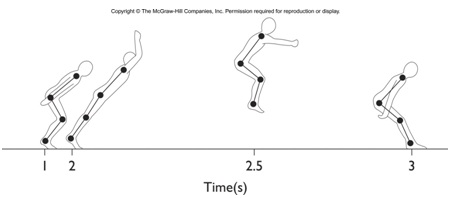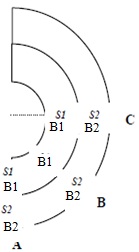Assignment:
1) A football team is in a position to kick a field goal to win a game. The ball is placed 36 m (approximately 39 yards) from the goalposts. The kicker kicks the ball with a resultant velocity of 20 m/s at an angle of 33°.
List your knowns:
1. What was the initial horizontal velocity?
2. What was the initial vertical velocity?
3. How long was the ball in the air (total flight time)?
4. What was the horizontal distance traveled? Did they win?
5. Calculate the following quantities for the diagram shown below:
a. The angular velocity at the hip over each time interval
b. The angular velocity at the knee over each time interval
Would it be meaningful information to calculate the average angular velocities at the hip and knee for the movement shown? Provide a rationale for your answer.

A soccer ball is kicked from the playing field. If the ball is in the air for 2.2 s (total flight time), what is the maximum height achieved?
2) Two cyclists B1 and B2) are racing at exactly the same velocity (say, 12 m/s) and come to a curve in the road (point A). At this point they are tied. Throughout the first half of the curve (points A-C), it appears that the cyclist in the outside lane (B2) remains tied with the cyclist in the inside lane (B1). Assume that the cyclist in the inside lane (B1) maintains a constant velocity. Using terms such as "constant", "zero", "same", "increase", "decrease", "positive", "negative" etc. answer the following questions:

a) What are the differences between the lineardistances traveled by the cyclists between points A and C. List the equation that explains this.
b) What are the differences between the tangential (linear) velocities of the cyclists at points A and C. List the equation that explains this.
c) What are the differences between the tangential (linear) accelerations of the cyclists between points A and C. List the equation that explains this.
d) What is the difference between the radialacceleration of B1 at points A and C. What is the difference (if any) between the radialacceleration of B2 at points A and C. List the equation that explains this.